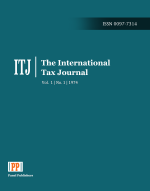Discussion on new climate issues: Eco-design, circular alternative and Intrusion Prevention System (IPS)
Keywords:
Eco-Design, Circular economy, Business-as-usual, IPS, Climate changeAbstract
An eco-inclusive environment is about interconnecting public services with the environmental concerns. It is obvious that the urban expansion makes higher demand on a wide range of resources. Predicting the future technological mutations and their environmental impacts are at the core of any impact assessment of a newly-designed product as the evolution waves are becoming shorter with the events of automation and nanotechnologies. The Eco-Design is aiming to contribute in more circular economy which eliminates the "business-as-usual" harming effects. In practice, a greater awareness that the circular economy model must prevail over the classical business as usual model by adopting innovative green design as a starting point. Likewise, a sustainable adaptation to climate change pressures is possible by rethinking the recycling materials' proceeds and mitigating waste. through the upgrading of the existing products.
Downloads
References
1- Accenture Strategy. "Circular Advantage: Innovative Business Models and Technologies to Create Value without Limits to Growth", (2014): 1-4.UK
2- European Commission. "communication from the commission to the european parliament, the council, the european economic and social committee and the committee of the regions –
3- Towards a Circular Economy: A zero Waste Programme for Europe", COM (2014) 398 final: 1-14.
4- Jeswiet, J, Hauschild, M. 26 (2005) "EcoDesign and Future Environmental Impacts", Materials and Design: 629- 34. Canadian. Broadcasting. Corporation [CBC]. Canada.
5- Meier, H, Roy, R and Seliger, G. (2010) "Industrial Product-Service Systems–IPS", CIRP Annals – Manufacturing Technology 59: 607-27.
6- Geissdoerfer, M., Savaget, P., Bocken, N.M.P., & Hultink, E.J. (2017).
7- Kirchherr, J., Reike, D., & Hekkert, M. (2017). Conceptualizing the circular economy: An analysis of 114 definitions. Resources, Conservation and Recycling, 127, 221–232. https://doi.org/10.1016/j.resconrec.2017.09.005
→ Discusses the diversity of circular economy definitions and contrasts with linear economic models.
8- OECD (2020). The Circular Economy in Cities and Regions. https://www.oecd.org/environment/circular-economy-in-cities.htm
→ Policy-based comparison of how circular principles challenge traditional urban economic models.
9- European Environment Agency (EEA) (2016). Circular economy in Europe – Developing the knowledge base. https://www.eea.europa.eu/publications/circular-economy-in-europe
→ Focuses on environmental performance differences between circular and business-as-usual scenarios.
Downloads
Published
How to Cite
Issue
Section
License
Copyright (c) 2025 The International tax journal

This work is licensed under a Creative Commons Attribution-NonCommercial-NoDerivatives 4.0 International License.








